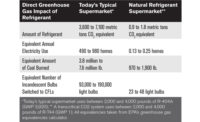When I started in this industry, there were three common refrigerants: R-12 for medium temperature applications, R-22 for air conditioning and R-502 for low temperature systems. I have not seen a white or purple cylinder of refrigerant for quite a while. These refrigerants were based on three elements - chlorine, fluorine, and carbon for CFCs like R-12 and R-502; and hydrogen, chlorine, fluorine, and carbon for HCFCs like R-22.
A technician could reasonably expect a handful of Thermostatic Expansion Valves (TEVs) to meet most of his needs. A few R-12 valves, a few R-502 valves, and a few R-22 valves.
But times have changed.
The Ozone Hole
In the early part of the 20th century, Antarctic explorers noticed some odd looking clouds in the South polar region, but it wasn’t until decades later during the International Geophysical Year (1957) that serious spectrometer measurements were made of the ozone layer in the Antarctic. By the middle of the 1980s, ground-based and high altitude measurements showed a marked decrease in the ozone level over the Antarctic.
In various scientific papers published in 1986 and 1987, the chemistry of ozone depletion by CFC refrigerants was proposed, and generally accepted. The long-lived refrigerants eventually move to the stratosphere, where they are exposed to strong ultraviolet light. This UV light breaks the bonds of the chlorine atom from the refrigerant molecule. This free chlorine atom reacts with ozone, destroying it.
Ozone plays an important role in protecting life on earth from very strong ultraviolet radiation from the sun. Without it all life on earth would be at risk.
So strong are the consequences of loss of the ozone layer that by September of 1987 the Montreal Protocol, limiting the use of CFCs and other chlorine bearing compounds, was signed. Within the next three years, 197 nations ratified the Protocol, and since have adopted a number of amendments.
Several refrigerants, some new, some old, were used to replace the CFCs. Faithful old R-22 gained ground in the short term, but replacements for R-12 and R-502 required an extensive range of new refrigerants. Some were touted as “drop-in” replacements, however this was seldom the case.
Most of the available newer refrigerants were zeotropic, with the significant exception of R-134a. Azeotropic refrigerants like R-134a and R-12 act as “pure” refrigerants. That is, all components evaporate and condense at the same temperature, and behave with a fixed pressure-temperature relationship.
Most of the newer refrigerants are 400 series zeotropic refrigerants that have a “glide.” Glide means the various components of the mixture boil, or condense, at different temperatures. Although inconvenient at times, the glide was less of a problem than the sheer number of refrigerants in use. Instead of three refrigerants, the technician was asked to support truck stock consisting of dozens of cylinders of refrigerants and TEVs. Common refrigerants included R-134a, R-404A, R-407A, R-407C, R-422A, R-422D, R-438A and R-507A. Some of these, like R-422D, were short lived in wide spread acceptance, but still required support in terms of the TEVs and refrigerant supply. Truck and wholesaler stock, and even manufacturer production, was becoming almost unmanageable.
So, while the ozone hole was on its way to being plugged, other alarms soon followed in our industry.
Global Warming
Global Warming Potential (GWP) became the next big concern as new compounds to replace CFCs and, ultimately, HCFCs came into use. HCFCs contain Hydrogen, as well as the chlorine, fluorine and carbon found in the CFC refrigerants. In many cases, the Ozone Depleting Potential (ODP) of these refrigerants is low or zero, but they are more inefficient, or they are Greenhouse gases that contribute to Global Warming.
Global Warming is inextricably related to Carbon Dioxide (CO2) in the atmosphere. The GWP of CO2 is defined as 1. The expectation that the large population of new refrigerants could be pared down to a workable few began to erode.
The refrigerant frontrunners turned out to be the biggest GWP offenders. R-134a has a GWP of 1430, R-404A of 3922, R-407A of 2107, and R-507A a whopping 3985 times the effect of pure CO2.
Once again, governments began to get involved but this time with much less direction, or agreement.
SNAP
It was time for a new acronym, SNAP. In this case, SNAP had nothing to do with getting something done quickly. Instead it was a search for a Significant New Alternative Policy.
SNAP was instituted as part of the Clean Air Act (CAA) of 1990. It was created to find alternatives to environmentally harmful substances, and was not limited to refrigerants. In 1994, the Environmental Protection Agency (EPA) was granted a “Final Rule”. Of course, where government is concerned – there is never a “final” rule. More about that later.
On July 21, 2017, the EPA published a list of acceptable substitutes, and very few were refrigerants in widespread use. Gases like R-407H, R-452A, R-442A, R-448A, R-458A, R-452C and R-453A were deemed acceptable, but without regard to how they could be supported in the field. At the same time, the EPA banned some widely accepted refrigerants for having a GWP that was too high.
Only a few weeks later, on August 8, 2017, the US court ruled that the EPA had overstepped its “final rule” authority in requiring manufactures to switch to “acceptable” alternative substances. However, the Court made it clear, that they were not saying the changeover to new substances was a bad idea, only that the EPA did not have the authority to force this implementation.
Where Are We Today?
Really, that’s anybody’s guess. One thing is indisputable though, our industry is changing and refrigerants will come and go with disheartening regularity.
So, how does a technician or contractor deal with the unknown terrain? Remember when a half-dozen TEVs met a large percentage of the requirements of the equipment being serviced? A solution is in hand and has been growing in acceptance for quite a while; EEVs.
Electronic Expansion Valves (EEVs) can be used on almost any refrigerant, and a single valve can control well over a wide range of capacities and evaporating temperatures.
The trend toward natural refrigerants can be problematic for some TEVs. And, while many older EEVs had motors within the refrigerant, making it challenging for use with Ammonia and Propane, newer designs with external stators, and in some cases, with stainless steel bodies, are well suited for the natural refrigerants that will almost certainly survive the vicissitudes of government actions.
Whether natural, or the current trending refrigerant, EEVs provide insurance against much of this unpredictable change. Switching to EEVs won’t just simplify truck stock, they also provide more precise control. Incorporating EEVs in a system that utilizes a “smart” refrigeration controller adds a whole new level of energy savings, communication capability for remote monitoring, and adjustment, of not only the valve, but the entire system. These controllers can support 15, or more, refrigerants with a simple change in setpoint. Should the refrigerant in a specific application change, most likely the controller setpoint can be changed to the chosen refrigerant without having to modify the system or controller. Additionally, some refrigeration controllers provide a history of performance that can be used for valve diagnostics – without hooking up gauges, or even being on the jobsite.
EEVs can bring improved temperature and superheat control to “standard” refrigeration systems, and also make difficult or expensive types of control possible. The figure below show how EEVs can be used to advantage in controlling the complete environment. This includes not just temperature, but humidity as well.
EEVs extend the types of applications, dovetail well into electronic control and remote monitoring, while helping clear up some of the concern with frequent refrigerant changes.
Maybe the current generation of refrigeration technicians will someday remember “the bad old days” when truck stock meant having a different refrigerant cylinder for each day of the week, and never having the right Thermostatic Expansion Valve (TEV) needed for the job.
Publication date: 3/19/2018
Want more HVAC industry news and information? Join The NEWS on Facebook, Twitter, and LinkedIn today!






Report Abusive Comment